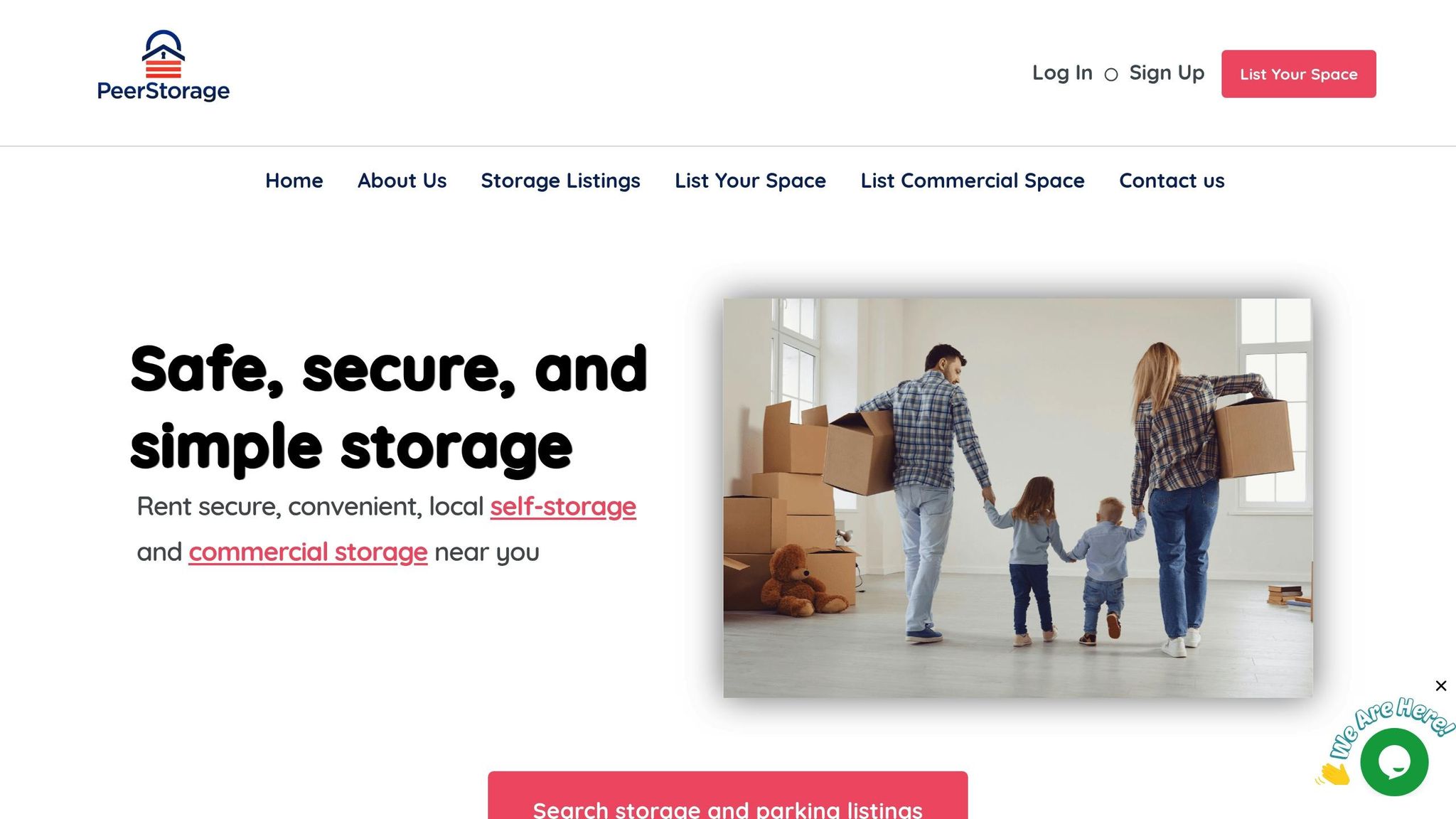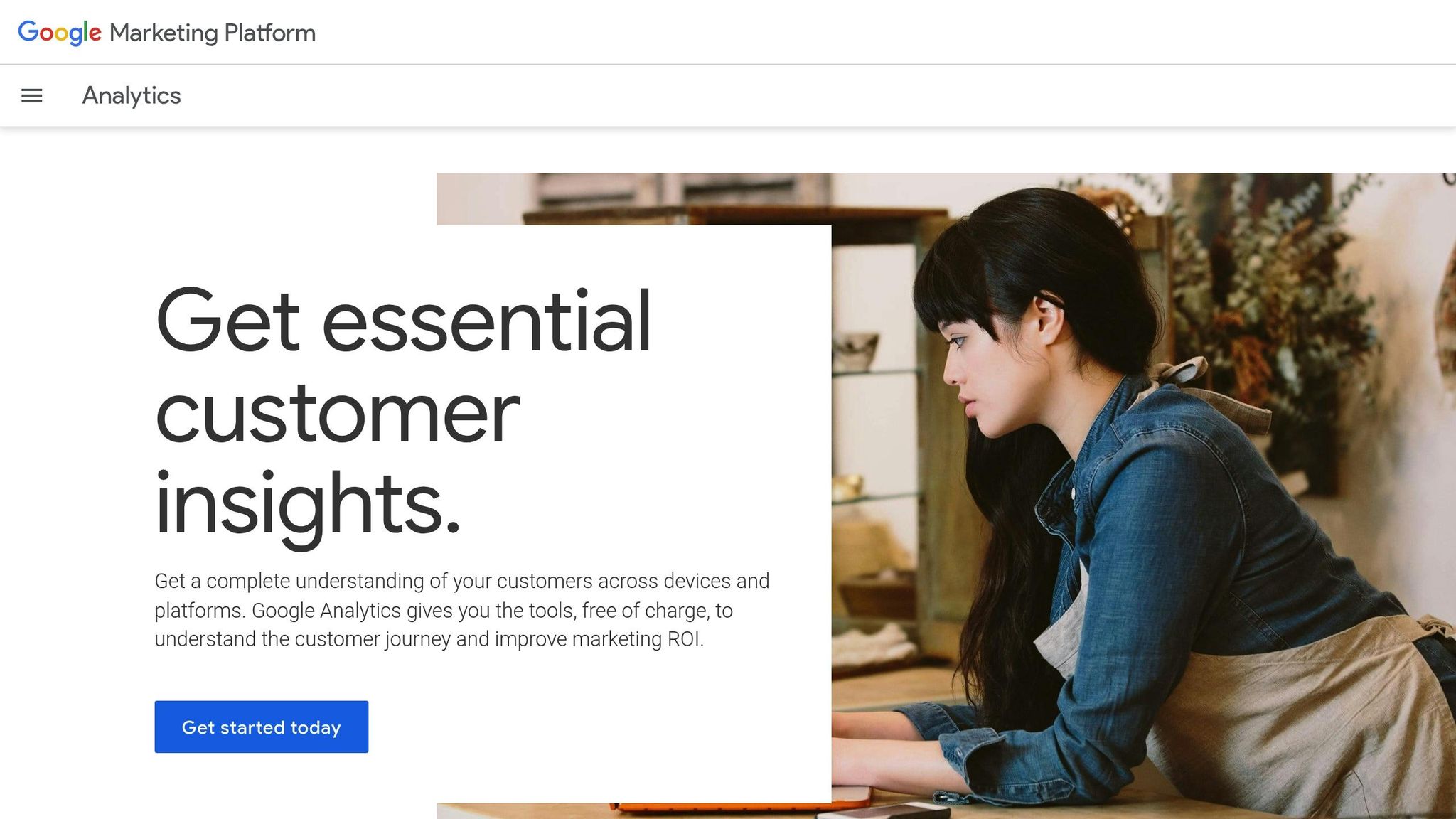Storage Unit Size Guide for Perfect Fit
- September 29, 2025
- Self Storage

Tracking marketing metrics is the key to understanding your storage hosting performance. These numbers reveal how well your efforts attract renters, convert interest into bookings, and generate revenue. Here’s a quick breakdown of what matters most:
Using tools like PeerStorage dashboards, Google Analytics, and local SEO insights, you can track these metrics, identify trends, and adjust strategies. The result? Better decisions, higher occupancy, and improved profits.
This guide will show you how to measure, analyze, and act on these metrics to grow your storage hosting business effectively.
Let’s dive deeper into the essential numbers that can make or break your success as a storage host. These metrics aren’t just numbers – they’re the key to understanding how well your business is performing and where you can improve.
Your listing views are a window into how much interest renters have in your storage space and how well you’re converting that interest into actual bookings. Website traffic includes both the total number of visitors to your PeerStorage listing and how they interact with it.
The conversion rate is the star metric here – it’s the percentage of visitors who book your space. For example, if 100 people view your listing and 5 book, your conversion rate is 5%. This number directly connects visibility to revenue.
Other helpful metrics include page engagement, such as how long visitors stay on your listing or how often they click on photos. If people leave quickly or don’t interact with your listing, it might be time to refresh your photos or tweak your headline to make it more appealing.
It’s a good idea to track these metrics weekly. A drop in conversions might mean your pricing needs adjustment, while a steady conversion rate paired with rising traffic shows your marketing is hitting the mark.
Now, let’s look at what it costs to gain new renters and the long-term value they bring.
Understanding how much you spend to attract a renter and how much they’re worth to your business is crucial. Customer Acquisition Cost (CAC) measures the total cost of gaining a new customer. This includes expenses like listing promotions, professional photography, or any other marketing efforts, divided by the number of new renters you acquire.
For instance, if you spend $200 on marketing in a month and gain 10 renters, your CAC is $20 per customer. This number helps you evaluate whether your marketing efforts are worth the investment.
On the flip side, Lifetime Value (LTV) shows how much revenue a renter generates over the course of their relationship with you. For example, if your average renter pays $150 per month and stays for 8 months, your LTV is $1,200.
The LTV to CAC ratio is a handy way to measure profitability. A ratio of at least 3:1 is ideal, meaning you earn $3 in revenue for every $1 spent on marketing.
Another useful metric is the payback period, which measures how quickly you recover your customer acquisition costs. If your CAC is $20 and your renters pay $150 monthly, you’ll recover your costs within the first week of their rental.
Once you’ve nailed down these cost and revenue metrics, it’s time to focus on how efficiently you’re using your storage space and the return on your marketing efforts.
Your occupancy rate tells you what percentage of your storage space is rented out at any given time. For example, if you have 4 units and 3 are booked, your occupancy rate is 75%. This metric shows how well your marketing efforts are filling your spaces.
It’s smart to track occupancy rates monthly and seasonally. Many storage hosts see higher demand during summer or around college move-in and move-out dates. Recognizing these patterns can help you plan promotions and adjust pricing strategically.
Marketing Return on Investment (ROI) is another must-know metric. It calculates how much revenue your marketing generates compared to what you spend. The formula is simple:
(Revenue from marketing – Marketing costs) ÷ Marketing costs × 100.
For instance, if you spend $300 on marketing in a month and it brings in $1,200 in rental revenue, your ROI is 300%. This means every dollar spent on marketing brought back $3 in revenue – a clear sign your efforts are paying off.
Finally, revenue per available unit combines occupancy rate and pricing to show how much each unit contributes to your bottom line. Multiply your occupancy rate by your average rental price to see this figure. It’s a great way to identify opportunities to either fill more spaces or adjust pricing for better returns.
Don’t forget to consider seasonal trends when analyzing these metrics. Comparing performance to the same period last year often gives better insights than looking at month-to-month changes.
Tracking your marketing efforts doesn’t have to feel overwhelming – using the right tools can simplify the process and make your data more actionable. By combining automation tools with platform features and third-party solutions, you can gain deeper insights into your performance metrics. Here’s a closer look at some tools and methods to help you stay on top of your marketing game.

PeerStorage’s dashboard offers helpful guidance for optimizing your listings, but it works even better when paired with additional analytics tools. While the dashboard provides essential tips and best practices, integrating external tools can give you a clearer picture of how potential renters interact with your listings. This combination allows you to uncover patterns and trends that might otherwise go unnoticed.

To expand on the data provided by PeerStorage, Google Analytics is a powerful tool for understanding how visitors discover and engage with your listings. It breaks down traffic sources – whether from search engines, social media, or direct visits – helping you refine your PeerStorage profile to align with your audience’s behavior.
For local visibility, a Google Business Profile is invaluable. It tracks local searches, phone calls, and even direction requests, giving you insight into how people are finding your storage space. By analyzing these searches, you can pinpoint the keywords renters are using and optimize your listing for stronger engagement.
Another key tool is Google Search Console, which shows how your listing appears in search results and highlights the search terms driving traffic to your PeerStorage profile. Together, these tools provide a well-rounded view of your local market presence and help you better understand user behavior.
Automation can save you time and ensure you’re consistently monitoring your performance. For example, you can configure Google Analytics to send regular summaries of your website traffic, conversion rates, and revenue performance. For metrics not automatically captured, tools like Google Sheets or Excel are great for calculating figures such as customer acquisition costs, lifetime value, and overall marketing ROI.
To stay on top of trends, tools like Google Data Studio can help you create dashboards that track occupancy rates, seasonal patterns, and pricing strategies. By balancing automated tracking with periodic reviews, you’ll be equipped to make data-driven decisions that enhance your hosting success.
Data becomes valuable when it leads to actions that increase bookings and revenue. The secret to successful storage hosting lies in turning metrics into practical steps that directly impact your bottom line.
Metrics can uncover trends that guide your decisions. For instance, if you see a drop in occupancy during slower months compared to peak times, it’s a sign to adjust your pricing and marketing. Offering lower rates during low-demand periods and premium pricing when demand spikes can make a big difference.
Traffic data is another goldmine. If visitors are leaving your PeerStorage profile too quickly, it might mean your photos, descriptions, or overall presentation aren’t hitting the mark. Try updating your visuals or rewriting your listing to highlight the most appealing features.
Geographic data also offers clues about your market reach. If most of your renters are local, focusing your marketing efforts on nearby communities may be more effective than casting a wide national net. On the other hand, if you’re attracting renters from farther away, emphasizing unique features or adjusting your pricing might help draw in more interest.
Additionally, consider how your listing performs across mobile and desktop platforms. Knowing where your bookings come from can help you optimize the user experience for the most popular devices.
Customer reviews and feedback are direct windows into what’s working and what needs improvement. If your ratings suggest room for growth, look for recurring themes in the comments. Whether it’s issues with accessibility, cleanliness, or communication delays, identifying these patterns allows you to make targeted improvements.
Response time is a common area of feedback. If renters mention slow communication, prioritize responding quickly during business hours. Prompt and clear replies not only resolve concerns but can also lead to better reviews and repeat business.
Feedback about your facility – like lighting or security – can guide practical upgrades. For example, adding better lighting or enhancing security measures can improve both the safety and appeal of your space.
Comments about pricing are equally valuable. If renters frequently ask about discounts or mention that your rates seem high, it’s worth comparing your prices to similar local offerings. On the flip side, positive feedback about value might indicate an opportunity to raise your rates slightly.
Low repeat bookings can be a red flag for customer satisfaction. Use this feedback to identify areas for improvement, refine your listing, and adjust your promotional strategies to better meet renter expectations.
Once you’ve analyzed trends and feedback, use this information to fine-tune your promotional efforts. For example, if social media posts generate bookings more efficiently than paid ads, it might make sense to shift more resources toward organic social content.
When running promotions, evaluate their effectiveness carefully. A discount might increase bookings, but you’ll need to weigh whether the extra volume offsets the lower profit margin. Alternatively, non-discount offers – like free moving supplies for a limited time – can attract renters without reducing perceived value.
Seasonal trends should also shape your campaigns. Keep an eye on peak periods and align your marketing efforts with these patterns for maximum impact.
If one advertising channel consistently delivers better-quality leads for the same spend, consider increasing your investment in that area. Instead of abandoning less effective channels outright, experiment with new ad copy, visuals, or targeting to improve performance.
Email marketing offers great potential when done right. Segment your audience into current renters and prospects, and tailor your messages to each group. Tracking engagement metrics can help you refine your approach. Personalized emails that address specific storage needs are often more effective than generic ones.
Finally, monitor conversion rates by traffic source. Direct traffic might indicate a strong reputation, while leads from referrals could point to valuable partnerships. Use this insight to focus your efforts where they’ll have the most impact, creating campaigns that are both efficient and effective.
Turning insights into action is where the magic happens. Advanced strategies take raw data and transform it into consistent revenue growth. By focusing on clear, measurable goals, you can turn your marketing efforts into a well-oiled, profit-generating machine. The key? Let performance data guide every decision.
Goals that are rooted in metrics need to be more than just numbers on a page – they should be achievable, meaningful, and tied to measurable outcomes. Start by assessing where your business stands today. This baseline helps you set realistic targets that push your business forward. Focus on key performance indicators (KPIs) like occupancy rates, revenue growth, and customer engagement. Then, break these down into smaller, incremental milestones to keep your progress on track.
Leverage tools like your PeerStorage dashboard and other analytics platforms to compare your performance against industry trends. Regularly reviewing these trends allows you to refine your approach. Make adjustments based on specific, data-driven actions to ensure your strategies stay aligned with market demands and continue driving growth.
This guide has shown how essential metrics not only track performance but also shape effective hosting strategies. By turning uncertainty into actionable insights, these marketing metrics help drive revenue growth and set successful hosts apart from those struggling to fill vacancies.
Start by focusing on the core metrics: website traffic, conversion rates, customer acquisition costs, and occupancy rates. These provide a solid foundation for evaluating the overall health of your storage business.
From there, tools like PeerStorage can take your marketing efforts to the next level. PeerStorage connects storage hosts with potential renters efficiently, boosts online visibility to improve SEO, builds trust through positive reviews, and showcases competitive pricing alongside detailed unit information.
Once you’ve established the basics, the next step is refining your strategies through data-driven optimization. This means measuring results precisely and making timely adjustments. Use analytics to identify trends like peak booking periods, understand customer preferences, and fine-tune pricing strategies. Metrics are most effective when they drive specific actions – such as launching new promotions during slow periods or reassessing marketing channels when acquisition costs climb.
To expand your storage hosting business online, start by setting up Google Analytics 4 (GA4) to monitor essential metrics like user behavior, traffic sources, and conversions. These insights reveal which marketing strategies are drawing the most visitors and generating leads. Pay close attention to reports like Traffic Acquisition to understand where your audience is coming from, and Engagement to pinpoint the pages that hold their interest.
Leverage this information to fine-tune your website and strengthen your local SEO efforts, making it easier for potential customers to discover your services. By continuously improving your online presence using these analytics, you can attract more targeted traffic, secure more bookings, and create new opportunities for passive income.
To reduce your Customer Acquisition Cost (CAC) while keeping occupancy rates high, focus on smart, budget-friendly marketing tactics. Start with local SEO to boost your property’s visibility in search results, making it easier for potential renters in your area to find you. Pair this with targeted social media ads to zero in on your ideal audience, and use retargeting campaigns to re-engage people who’ve already checked out your property but haven’t committed yet.
Another key move? Adjust your pricing based on occupancy trends. Staying competitive and flexible with rates can make your property more appealing to renters. At the same time, build trust and credibility by encouraging positive online reviews and actively engaging with your community. This not only enhances your reputation but also drives conversions without requiring a hefty marketing budget. By blending these approaches, you can strike the perfect balance between cutting costs and maintaining high occupancy.
Seasonal trends have a big impact on the demand for storage spaces. For example, interest often spikes during summer and the holiday season. These busy times are a great opportunity to adjust your pricing and introduce targeted offers. Think about deals like discounts for first-time renters or referral bonuses to draw in more customers and boost your revenue.
On the flip side, slower seasons call for creative strategies to keep occupancy up. You could roll out special offers like "Spring Cleaning Discounts" or limited-time deals to appeal to customers. By tweaking your pricing and tailoring promotions to fit the ebb and flow of seasonal demand, you can keep bookings steady and make the most of your earnings year-round.
Join The Discussion